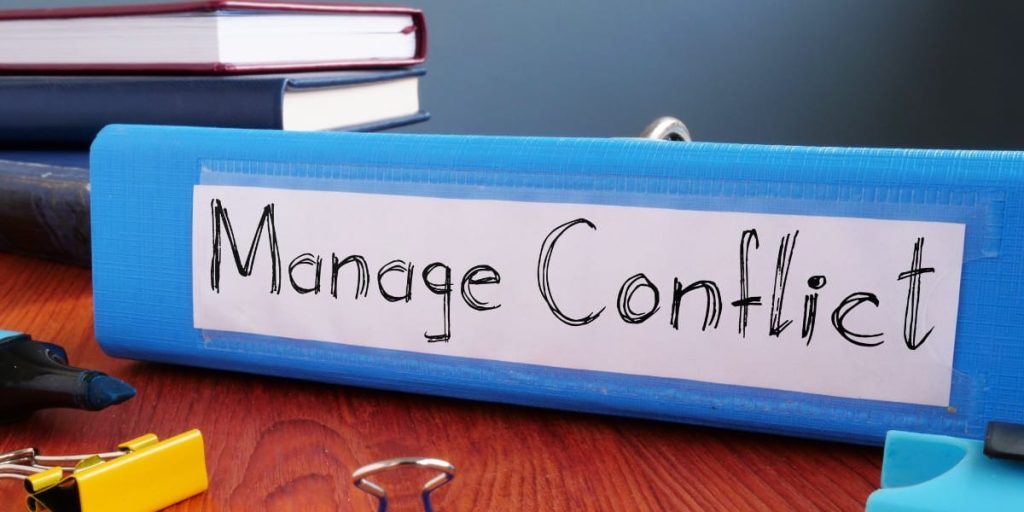
Effectively managing employee conflict in the workplace is a talent. Learn how to avoid unplanned conflicts at work by following these tips.
Do you recall a time when a colleague gets on your nerves? It disturbs you that you can never see things from their perspective. Or maybe you feel unheard because of your boss’s poor workplace conflict management skills.
Conflict in the workplace occurs more often than you may expect. As stated in the study “Workplace Conflict and How Businesses Can Harness It to Thrive.”, 85% of workers experience workplace conflict at some point in their employment, and 29% of those workers experience workplace conflict virtually continuously.
However, not all conflicts in the workplace are harmful. Solving disagreements and having tough talks at work may make everyone’s lives easier.
We’ve all been taught that avoiding confrontation is preferable, yet there are situations when it leads to positive outcomes. Here, you’ll learn effective strategies for resolving workplace conflicts.
Table of Contents
What Causes Employee Conflict in The Workplace?

Teammates often fight and workplace conflict may result from various reasons such as personality, work style, or even approach to the topic.
Workplace conflict is possible everywhere, even in a Zoom conference. It might come through in the way we speak and carry ourselves. Individuals use words not only to show they don’t agree with another person’s opinion or the quality of their work; they may also show it via direct action. Disrespect and hostility may grow out of a lack of active listening abilities.
There is no simple example of workplace conflict. Ultimately, there’s always a person on both sides of any dispute. Since we all bring our complete selves to the office, disagreements will undoubtedly arise. However, similar problems exist in most organizations.
Ultimately, there are the six main factors that can be identified as the root of workplace tensions:
- Disagreement over the best approach to a problem.
- Difficulties stemming from management’s leadership and conduct.
- Ineffective exchange of information about roles and duties.
- Politics at work can lead to workplace conflict or unhealthy rivalry.
- Discrimination or a hostile work environment.
- Personal experiences that affect team members’ attitudes and job performance.
5 Tips for Dealing with Employee Conflict in The Workplace

No matter how much we’d all want it to be otherwise, philosophical and mental divides are inevitable, given that the very nature of humans themselves is to err. The challenge then becomes how to resolve disagreements productively.
Accepting and addressing workplace conflict via effective resolution procedures is crucial for an organization’s health and effectiveness. While it’s necessary to have conflict management strategies, any procedure’s success will rely on the willingness and understanding of all parties involved.
The following are some suggestions for improving one’s dispute-resolution skills in the workplace:
1. Specify What Kinds of Conduct Are Allowed
Assumptions may be dangerous. A clear understanding of what is and is not appropriate behavior might help reduce tensions.
Workplace conflicts may be avoided by adopting conflict management activities related to cooperation, team building, leadership development, and talent management, developing a framework for making decisions, and publicizing a delegation of authority statements.
Conflicts can also be avoided by clearly outlining roles and responsibilities and establishing a transparent chain of command that facilitates open lines of communication. Communicate openly and explicitly what is and is not acceptable.
2. Try to Avoid Workplace Conflict in The First Place
While avoiding every disagreement is impossible, we’ve found that avoiding workplace conflict in the first place is the key to successfully resolving them. You can prevent some confrontations if you actively look for possible conflict zones and intervene quickly and decisively.
If a disagreement does arise, you may lessen its impact by addressing workplace conflict swiftly. Spending time recognizing and comprehending underlying tensions might help mitigate friction.
3. Be Aware of the WIIFM (What’s In It For Me) Perspective
It is crucial to have an awareness of the WIIFM perspective of the other professional. Putting yourself in other people’s shoes before passing judgment is vital. Workplace conflict may be avoided by aiding others around you in accomplishing their goals.
If you approach dispute resolution from the standpoint of doing what is best for others, you will discover fewer roadblocks to a positive outcome.
4. Choose your Fights Wisely
Choose your fights wisely, and don’t get into an argument only to start one. However, if the problem is significant enough to spark an argument, it is certainly substantial enough to remedy. People will do what it takes to bridge philosophical or positional divides if the topic, scenario, or situation is significant enough and the stakes are high enough.
5. View Workplace Conflict As An Opportunity
Almost every quarrel contains the seeds of a significant educational opportunity. As long as people are willing to disagree with one another, there will always be room for improvement.
If you’re a CEO, you’re losing out on a fantastic opportunity if you don’t use conflict management strategies to strengthen your team and leadership skills. When handled appropriately, contrasting viewpoints may spark creativity and new insights in ways that would otherwise be impossible. Good leaders can always find something positive in a variety of perspectives.
5 Examples of Effective Workplace Conflicts Management

The following are scenarios where disputes may arise in the workplace and some solutions that a manager might use.
1. Conflicts Over Specific Tasks
This is the problem that crops up in teams if one person delivers information that another team member needs to do their share of the work late. If this happens often, the team member being held up may begin to feel disrespected.
Having an understanding of who is responsible for what may help to settle this conflict. To better understand how workflows might achieve excellent synchronization, it is helpful to clarify the processes they employ to complete their duties.
2. Conflict With the Manager’s Management Style
Conflicts between managers and workers may arise even when everyone involved is doing their best.
For instance, a boss with a strong type A personality can set lofty objectives for a subordinate, causing the latter to feel overburdened. Or a boss may like to be hands-off, while an employee may need more excellent supervision.
The goal of the conversation should be to work together toward actual answers, so be careful to set clear boundaries and ensure everyone involved knows this.
An example of this workplace conflict is asking workers who seem overburdened by their responsibilities to create a spreadsheet outlining their obligations and providing rough timeframes. It’s common for managers to have weekly one-on-one sessions with each employee.
So, the subordinate and the manager may assess the current workload and figure out how to delegate or improve efficiency. Maintaining open communication lines between staff and management is crucial to improve teamwork.
3. Conflicts Arising from Performance Reviews
Collaborate one-on-one with the worker to map out a strategy for enhanced performance, complete with measurable goals and timeframes. Get your staff involved in goal-setting by asking for their input.
4. Personality Conflicts
It might be challenging to collaborate with individuals who have different styles and personalities than your own. People need to be shown compassion and understanding since one bad experience does not define them.
One of the finest things to do when working with a personality clash is to sort out and resolve the matter informally as soon as possible before it escalates.
5. Discrimination
One of the most severe types of workplace conflicts is discrimination. Practically every crisis calls for the intervention of human resources.
The number of discrimination claims filed in the United States in 2020 was 67,448. Managers and the organization need to emphasize the importance of diversity and tolerance as soon as a claim is made.
Next, managers should give the complaining worker their entire attention without interjecting or conflating, initiate a conversation about the problem and establish concrete, attainable objectives for resolving it.
Conclusion
Wars create rifts among people. Poorly managed conflict may have far-reaching and devastating consequences. Loss of motivation, efficiency, calm, and cooperation are just a few of the many benefits businesses and people suffer.
Issue resolution is an ongoing process, and as we develop our abilities and experience success, we may look forward to the next conflict and the next lesson, hopefully with a greater understanding of how to handle it and more confidence in our abilities as a result.
Looking for a way to upgrade your employee management system? Book a call with our experts today!
